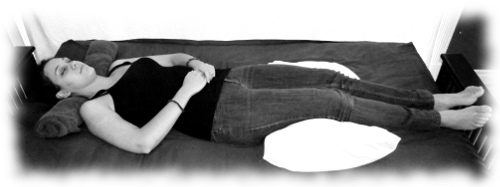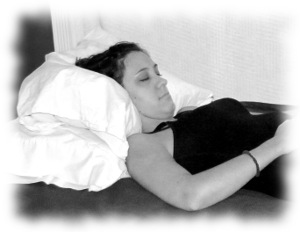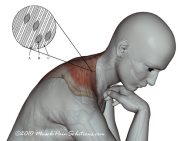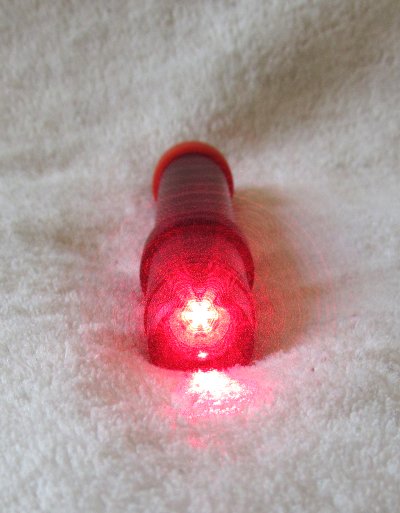Your Sleep Positions: Could they be causing you Pain?
Since you spend (or are supposed to spend) 1/3 of your life in bed, sleep positions can contribute dramatically to your muscle pain. When you sleep in a more ideal posture, your muscles get to relax and repair through the night. When you are in a less than ideal position, they can tighten up and shorten, or become over stretched through the night, causing you pain when you try to use them the next morning. Here are some things you can try to get more restful sleep. Sometimes the answer to your pain is really that simple!
Sleep Positions: On your back

Of all the sleeping positions, this is probably the most restful posture for your neck and back. This is the only position in which all of the little muscles between each vertebra (called paraspinals) can fully relax. There are a few considerations to maximize the restfulness of back sleeping.

Neck Sleeping Position: Your Pillow
Pillow selection is fairly easy if you are strictly a back
sleeper. Try this - stand with good posture against a wall. Observe how
far your head is from the wall. This is about how much support you will need
behind your head. You should ideally have a little more support under your neck
than your head, which is why many cervical pillows have that funny
shape. Don't use "too much" pillow, because it will push your neck up too far, over stretching the muscles and ligaments in the back, and shortening the ones in the front.
You can imitate this shape with a pillow that you can scrunch up under your neck like a feather pillow, or one with a small moveable filler. These can work to support your neck to keep your head from rolling to side to side.
Arm Position
Your arms can go to your sides, on your stomach, or if you have no shoulder problems, up near your head. You can also hug a pillow. Any of these positions are fine for your back.
Leg Sleep Positions: Another Pillow
Another area that is important, is the position of your legs for your low back comfort. Keeping your legs mostly parallel is important, because if you sleep with your leg out to the side in a figure 4 position, you are putting continual pressure on your pelvis, and can torque the pelvis or low back. If you have a sensitive low back, this can cause pain throughout the next day. Putting a pillow, or even two under your knees can take the pressure off your back and allow you to rest more comfortably. This is actually the ideal position for someone that has problems with the disks in their low back. If you tend to roll during the night, there are pillows that allow for side and back sleeping.
Position of Your Feet
When you first slip into your newly made bed, on your back, the covers will pull your feet down into a pointed position. This is not a great position to stay in all night. It will eventually cause foot problems like plantar fasciitis. Instead, use your feet to pull the blankets up around your feet and make a little "tent" so your feet can point up comfortably.
Sleep Positions: Side Sleeping
This can also be a good sleep position, if done right. There are several considerations. The first is the pillow.
Neck Position
- Use a pillow (or two) that fills the space between your neck and the point of your shoulder.
- Don't use so much pillow that it pushes your head up.
- Try supporting your neck with an extra little pillow under your regular one at the level of your neck.
- Consider a cervical pillow.
Arm Position
A great way to deal with your arms when sleeping on your side, is to hug a pillow. You can also cross your arms. Avoid sleeping on your arm, because it shortens neck muscles, and over stretches certain shoulder muscles.
Leg Position
If you have a very small frame, this might not be as important, but most people will do much better with putting a pillow between their knees. When you don't, your top leg pulls your pelvis into a tilt away from your back and sometimes a twist forward as well, which can put stress on your muscles and pull your pelvis and back out of alignment.
Another consideration is that you want to sleep as straight as possible. When you curl up, you imitate the seated slumped position that most people are in throughout the day, and you never give your "front" muscles time to stretch out.
For more pictures and more information, check out Side Sleeper.
Sleep Positions: Stomach Sleeping

This is one of the least favorable positions to sleep in. Notice these problems in the image above:
- Her head is turned all the way to the side shortening many neck muscles on that side and lengthening them on the other, putting a lot of stress on her neck joints.
- The curve in her upper back is somewhat exaggerated, as is the curve in her low back.
- Her shoulders are shrugged up, shortening the upper trapezius muscles, and her elbows are bent, shortening the biceps.
- Her toes are pointed, shortening the calf muscles, which can actually contribute or cause plantar fasciitis.
If you can't fall asleep in any other position, review my page on stomach sleeping for ways to break the habit and modifications you can try.
Sleep Positions: All Over!
This is definitely the hardest "position" to fix, since most often if you do this, you are a heavy sleeper. If you are a light sleeper, I would recommend having pillows for back and side sleeping available. There are pillows that work for both with different sections for back and side sleeping. One thing that I have done in the past is have a small moldable pillow under my larger one. When I am on my back, I just use the small one, and when I roll to my side, I add the larger one. I am a light sleeper, so this works for me.
If you are a heavier sleeper, and toss and turn, I would recommend using a pillow that will support you and be ok with either position. I would also recommend trying a body pillow that you can hug that will support you and keep you from ending up on your stomach.
You also may be tossing and turning from pain, in which case dealing with the pain will be the first good step to sleeping more restfully.
If it is stress keeping you tossing and turning, try stress relief techniques.
Return from Sleep Positions to Muscle Pain Solutions Home Page.
Click here for my
FREE Ebook
and Newsletter!
Find your pain here!

Related Pages



